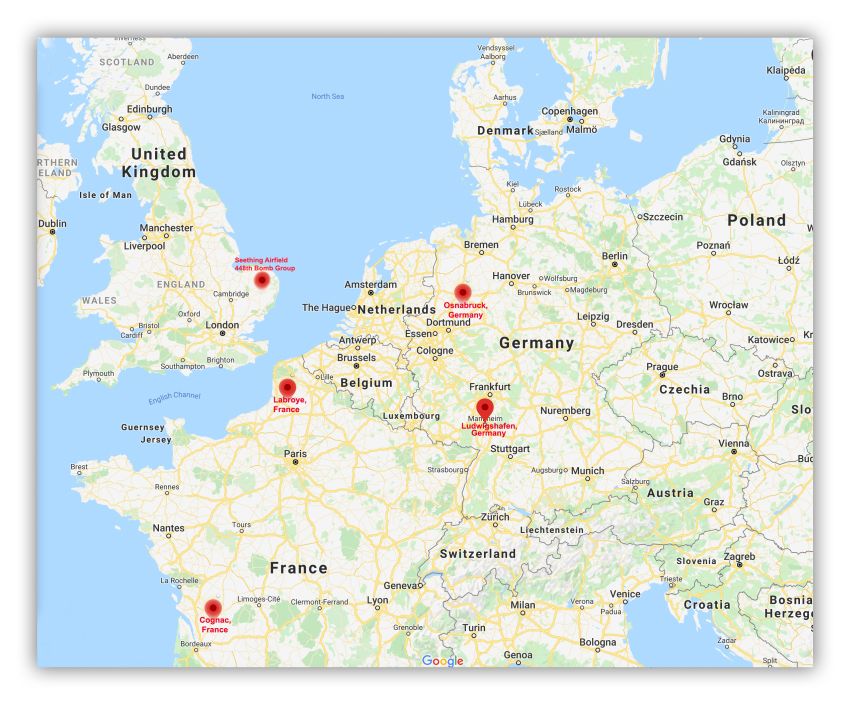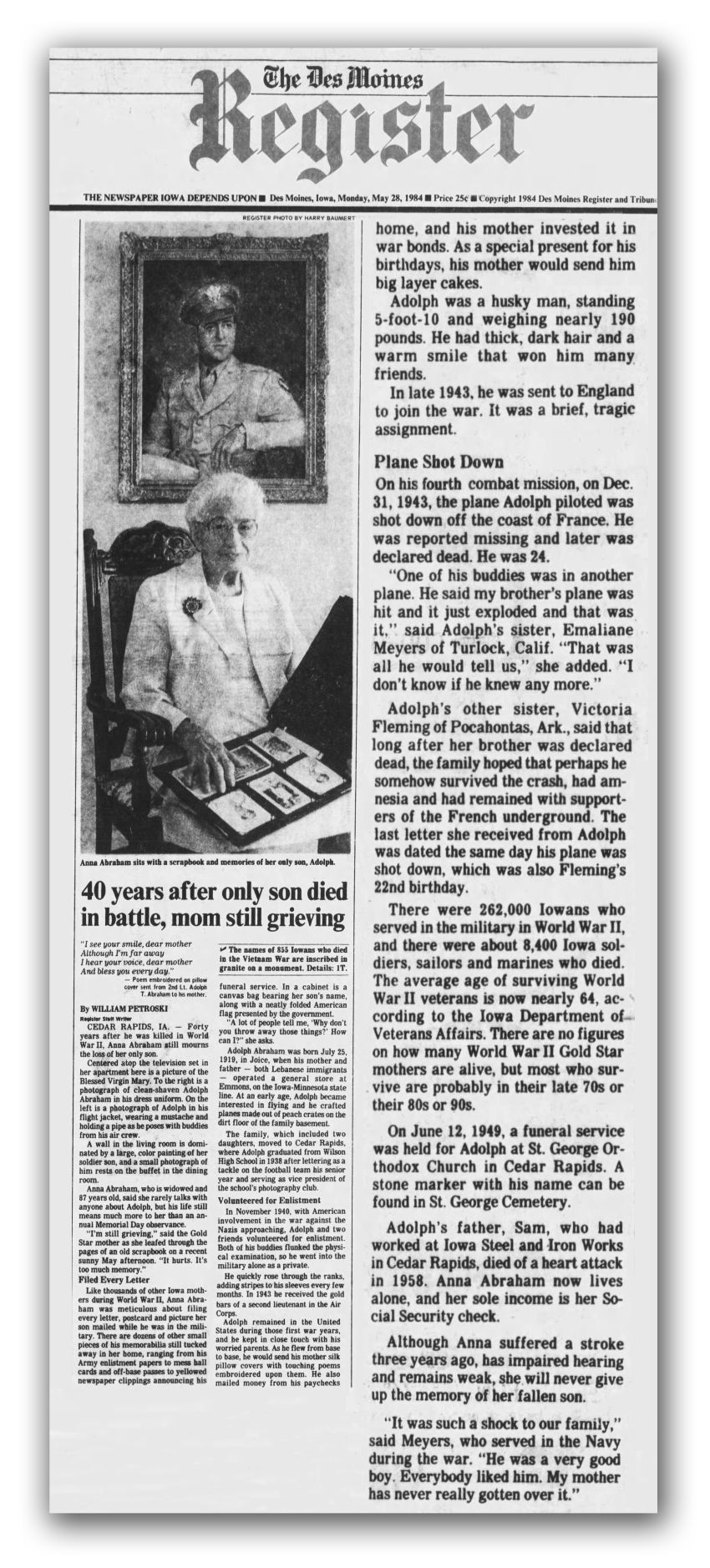Click to view a High Resolution image

Click to view a High Resolution image

Click to view a High Resolution image


m a r k e r i c k s o n p a i n t i n g s Lt. Ernest Anders Erickson Air Corps 1942 - 1945
Click to view Lt. Ernest Anders Erickson's complete thirty five mission list and twelve B-17 Flying Fortresses flown between March 27th thru August 26th, 1944 out of Horham Airfield, England.
|
Adolph Tom Abraham was born on July 25th, 1919 in the town of Joice in Worth County, Iowa. His parents are Fahdeh Anna 'Annie' Nassif Attiyeh and Simon 'Sam' Jacob Abraham and both were born in Ain Arab, Lebanon. Tom has two sisters, Emaliane Dorothy (Sewell-Meyers) and Victoria (Fleming). Tom's mother Annie is the younger sister of Delleh 'Della' binto Jirji Nassif Attiyeh Boutrous. Emaliane joined the U.S. Navy in 1942, serving as a nurse and was stationed at Bethesda Naval Hospital in Bethesda, Maryland till the end of 1945. Della is the mother-in-law of my Father Ernest Anders Erickson's sister, my Aunt Dian Marcella (Erickson) Boutrous. Dian's husband Floyd Nick Boutrous (son of Delleh) is the first cousin of Adolph Tom Abraham, who the family called Tom or Tommy. Tom joined the Army on November 19th, 1940 in Cedar Rapids, Iowa when he was twenty one years old. At the time he was working at the Master Food Market in Cedar Rapids. Tom completed Basic Army Training in 1941 and by 1942 joined the Army Air Corps with the intent of being a pilot. Tom was assigned to the 448th Bombardment Group of the 8th Air Force, that was being formed in the spring of 1943 at Gowen Field near Boise, Idaho. From there, the 448th moved to Wendover Field, Utah in July of 1943, then in September headed to Sioux City, Iowa. Tom had a chance to see his family in Cedar Rapids during this period of his preparation to be sent to England for Combat Flying. On December 1st, 1943, Tom now a pilot with the 713th Squadron of the 448th headed to Seething Airfield in England. The 448th now consisted of four Squadrons: the 712th, 713th, 714th and the 715th. Tom along with 713th Squadron flew their first mission over Nazi occupied Europe on December 22nd, 1943 targeting Osanabruck, Germany. He would follow that on December 24th with a mission over Labroye, France and his third mission over Ludwigshafen, Germany on the 30th of December. The following day on New Year's Eve, December 31st, 1943, Tom and the 713th Squadron would be heading for a target over Cognac, a commune in the Charente department in southwestern France. Details of that mission are below. Attached is a map of Europe and Tom's four missions he undertook at the end of 1943 with the 448th Bombardment Group out of Seething Airfield, in England. Piloting a B-24 Liberator, B-25 Mitchell or a B-17 Flying Fortress in 1943, was as tough as it came during the Daylight Bombing Campaign that the 8th Army Air Corps/ 8th Air Force undertook in 1942. The year 1943 of the four year campaign turned out to be the most horrendous of all years for losses of Heavy Bombers and in lost, missing and or captured Air Crews. Ten crew men to a ship and you can imagine the numbers. Prime Minister Winston Churchill was dead-set against the 8th's current 'Daylight Bombing Campaign', which he considered an absolute waste of planes and men. He fretted over the results, which in his mind were meager, compared to the Heavy Bombers and crews lost in 1943. Churchill felt the night British Bombing Strategy was far more effective. He demanded from President Roosevelt that the Americans join with the Royal Air Force's Bomber Commander Arthur 'Bomber' Harris' assault on Nazi Occupied Europe. And in that, Churchill felt more specifically for the Americans to take part in the RAF's continued area bombing of German cities. It took Major Gen. Ira C. Eaker, a World War I fighter pilot and commander of the Eighth Air Force, with serious prodding by the commanding general of the Army Air Forces, General Henry 'Hap' Arnold, to help convince Churchill to back off from his stance. Churchill eventually gave his approval, though possibly tentatively, so the boys of the Mighty 8th had to prove him wrong. The chances to complete your Air Combat duty was less than 50-50 at the time in 1943. 25 missions (eventually 30 then 35 missions) had to be accomplished to complete one's Air Combat tour of duty. Whether you were a pilot or a crew member, made no difference and the chances of getting killed, wounded or taken prisoner was in the high numbers, not to even mention the psychological damage these young men withstood. In 1942 and most of 1943 the Heavy Bombers had no fighter air cover going into the target or on their return flight back to England. It was like being out at sea in the 19th Century with little breeze and your sails almost still and pirates were approaching. Even if the ships survived the treacherous flak (Anti-Aircraft gunfire) fields approaching and leaving their assigned targets, the Luftwaffe's wild wolf packs of fighter planes searing through the skies of Europe, picked off Bombers easily. Stragglers that fell out of formation were slaughtered by Messerschmidt 109 attacks and the most deadly fighter aircraft of the war, the Focke-Wulf FW-190 assaults that shredded the slow moving RAF and American Heavy Bombers. It was a daunting affair up there 30-40 thousand feet in the heavenly skies. My father, Lt. Ernest Anders Erickson survived 35 missions piloting twelve B-17s in 1944 with the 95th Bomb Group. His survival was helped by the P-38 Lightening, P-47 Thunderbolt and my father's favorite, as he called, 'old friend out there in the skies,' the P-51 Mustang. On December 31st, 1943, Lt. Adolph Tom Abraham of the 448th Bomb Group, left Seething Airfield, southeast of Norwich, East Anglia, England piloting the B-24 Liberator, #42-2948. Tom headed the ship along with other B-24s of the 713th Squadron for a target in France. The 713th formed over Hardwick and proceeded to their final assembly at Portland Hill. Flying at 15,000 feet Tom's ship crossed the English Channel and arrived at the French coast at 12:07pm. The 713th then proceeded on a course that would take them deep into France. Bad weather met them in France and inevitably it would prevent the Squadrons from taking on their Primary Target, the La Rochelle La Leu Airfield. Severe heavy cloud cover pushed the 713th Squadron to their Secondary Target over Cognac, France, the Chateaubernard Airfield. Sightings of enemy fighters buzzed through the crews headsets. Short bursts of 50mm machine gunfire erupted from the ships as the fighters slid through the formations. As the 713th approached Chateaubernard, the flak began as it always did over targets. Becoming accustomed to that was difficult, even as the fighters began to back off and watch the spectacle from a safe distance from the deadly Flak fields. 'Bombs Away' was called at 12:32pm, signaled by a red flare fired by the Radio Operator of the lead ship. It had just been 25 minutes since arriving over France, surely feeling intensely longer, with the maundering fighter attacks and the Flak bursts they were at the time flying through. Time tended to slow down, as the men held on and performed their duties. As Tom's ship let go of their Bomb load over the target, with Flak coming up throughout the ships, the formation broke up over Chateaubernard. Most began to make the big swinging arc heading towards home, England. At this point Tom's B-24 was hit by a direct flak burst, ripping through the fuselage. One of the engines exploded as the wing fell away from the ship. The remains of Tom's B-24 broke apart quickly, collapsing in heaping wreckage. It fell to earth in a slow painful spiral, billowing smoke and flame, that was witnessed and reported by other crews of the 713rd. Two crew members were fortunate to survive the blast and parachuted to safety, only to be captured by the Germans and spending the next two and half years in a Prisoner of War camp. Lt. Adolph Tom Abraham, twenty four years old and seven other crew members lost their lives that day. The losses of Allied crews were daunting and hit families hard across the world, from the States to England, Canada, New Zealand, Australia and beyond. My father's safe return was one of many, yet the others that were not as fortunate, we remember the best we can. Tom's sacrifice is honored here by the family that he never had a chance to meet. Fly safe into the eternal trail of the blue skies.
Below you will find a Des Moines Register newspaper article from May 28th, 1984
about Tom's mother, Fahdeh Anna 'Annie' Nassif Attiyeh. |




h o m e